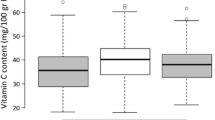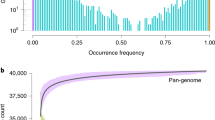Abstract
We have shown that a major QTL for fruit weight (fw2.2) maps to the same position on chromosome 2 in the green-fruited wild tomato species, Lycopersicon pennellii and in the red-fruited wild tomato species, L. pimpinellifolium. An introgression line F2 derived from L. esculentum (tomato) x L. pennellii and a backcross 1 (BC1) population derived from L. esculentum x L. pimpinellifolium both place fw2.2 near TG91 and TG167 on chromosome 2 of the tomato highdensity linkage map. fw2.2 accounts for 30% and 47% of the total phenotypic variance in the L. pimpinellifolium and L. pennellii populations, respectively, indicating that this is a major QTL controlling fruit weight in both species. Partial dominance (d/a of 0.44) was observed for the L. pennellii allele of fw 2.2 as compared with the L. esculentum allele. A QTL with very similar phenotypic affects and gene action has also been identified and mapped to the same chromosomal region in other wild tomato accessions: L. cheesmanii and L. pimpinellifolium. Together, these data suggest that fw2.2 represents an orthologous QTL (i.e., derived by speciation as opposed to duplication) common to most, if not all, wild tomato species. High-resolution mapping may ultimately lead to the cloning of this key locus controlling fruit development in tomato.
Similar content being viewed by others
References
Benerjee MK, Kalloo (1989) The inheritance of earliness and fruit weight in crosses between cultivated tomatoes and two wild species of Lycopersicon. Plant Breed 102:148–152
Bernatzky RB, Tanksley SD (1986) Toward a saturated linkage map in tomato based on isozymes and random cDNA sequences. Genetics 112:887–898
Bonierbale MW, Plaisted RL, Tanksley SD (1988) RFLP maps based on common sets of clones reveal modes of chromosome evolution in potato and tomato. Genetics 120:1095–1103
DeVicente MC, Tanksley SD (1993) QTL analysis of transgressive segregation in an interspecific tomato cross. Genetics 134: 585–596
Doebley J, Bacigalupo A, Stec A (1994) Inheritance of kernal weight in two maize-teosinte hybrid populations: implications for crop evolution. J Hered 85:191–195
East EM (1915) Studies on size inheritance in Nicotiana. Genetics 1:164–176
Edwards MD, Stuber CW, Wendel JF (1987) Molecular-marker-facilitated investigations of quantitative trait loci in maize. I. Numbers, genomic distribution, and types of gene action. Genetics 166:113–125
Edwards MD, Helentjaris T, Wright S, Stuber CW (1992) Molecular-marker-facilitated investigations of quantitative trait loci in maize. Theor Appl Genet 83:765–774
Eshed Y, Zamir D (1994) A genomic library of Lycopersicon pennellii in L. esculentum: a tool for fine mapping of genes. Euphytica 79:175–179
Fatokun CA, Menancio-Hautea DI, Danesh D, Young ND (1992) Evidence for orthologous seed weight genes in cowpea and mung bean based on RFLP mapping. Genetics 132:841–846
Feinberg AP. Vogelstein B (1983) A technique for radiolabeling DNA restriction fragments to a high specific activity. Anal Biochem 132:6–13
Grandillo S, Tanksley S (1995) QTL analysis of horticultural traits differentiating the cultivated tomato from the closely related species L. pimpinellifolium. Theor Appl Genet (submitted)
Hunziker AT (1979) South American Solanaceae: a synoptic survey. In: Hawkes JG, Lester RN, Skelding AD (eds) The biology and taxonomy of the Solanaceae. Academic Press, London, pp 49–85
Johanssen W (1909) Elemente der exakten Erblichkeitsllehre. Fischer, Jena
Khalf-Allah AM, Mousa AG (1972) Relative importance of types of gene action for early yield, total yield and fruit size in tomato. Egypt J Genet Cytol 1:51–60
Kosambi DD (1944) The estimation of map distances from recombination values. Ann Eugen 12:172–175
Lander ES, Green P, Abrahamson J, Barlow A, Daly MJ, Lincoln SE, Newburg L (1987) MAPMAKER: an interactive computer package for constructing primary genetic linkage maps of experimental and natural populations. Genomics 1:174–181
Lindhout P, Heusden SV, Pet G, Van Ooijen JW, Sandbrink H, Verkerk R, Vrielink R, Zabel P (1994) Perspectives of molecular marker-assisted breeding for earliness in tomato. Euphytica 79:279–286
MacArthur JW, Butler L (1938) Size inheritance and geometric growth processes in the tomato fruit. Genetics 23:253–268
Miura H, Parker BB, Snape JW (1992) The location of major genes and associated quantitative trait loci on chromosome arm 5BL of wheat. Theor Appl Genet 85:197–204
Muller CH (1940) A revision of the genus Lycopersicon. USDA Misc Publ 328, 29
Nelson C (1994) Molecular mapping in bread wheat. PhD dissertation, Cornell University, Ithaca, New York
Nilsson-Ehle H (1909) Kreuzunguntersuchungen an Hafer und Weizen. Lunds Univ Aarskr NF 5:1–122
Olmstead RG, Sweere JA (1994) Combining data in phylogenetic systematics: an empirical approach using three molecular data sets in the Solanaceae. Syst Biol 43:467–481
Paterson AH, Lander ES, Hewitt JD, Peterson S, Lincoln SE, Tanksley SD (1988) Resolution of quantitative traits into Mendelian factors using a complete linkage map of restriction fragment length polymorphisms. Nature 335:721–726
Paterson AH, De Verna JW, Lanini B, Tanksley SD (1990) Fine mapping of quantitative trait loci using selected overlapping recombinant chromosomes in an interspecies cross of tomato. Genetics 124:735–742
Paterson AH, Damon S, Hewitt JD, Zamir D, Rabinowitch HD, Lincoln SE, Lander ES, Tanksley SD (1991) Mendelian factors underlying quantitative traits in tomato: comparisonacross species, generations and environments. Genetics 127:181–197
Rick CM (1976) Tomato (family Solanaceae). In: Simmonds NW (ed) Evolution of crop plants. Longman Publications, UK, pp 268–73
SAS Institute Ince (1989) JMP users guide: statistics. SAS Institute, Cary, North Carolina
Stuber CW, Edwards MD, Wendel JF (1987) Molecular-marker-facilitated investigations of quantitative trait loci in maize. II. Factors influencing yield and its component traits. Crop Sci 27:639–648
Stuber CW, Lincoln SE, Wolff DW, Helentjaris T, Lander ES (1992) Identification of genetic factors contributing to heterosis in A hybrid from two elite maize inbred lines using molecular markers. Genetics 132:823–839
Tanksley SD, Ganal MW, Prince JP, de Vicente MC, Bonierbale MW, Broun P, Fulton TM, Giovannoni JJ, Grandillo S, Martin GB, Messeguer R, Miller JC, Miller L, Paterson AH, Pineda O, Roder MS, Wing RA, Wu W, Young ND (1992) High-density molecular linkage maps of the tomato and potato genomes. Genetics 132:1141–1160
Xiao J, Li J, Yuan L, Tanksley SD (1995) Dominance is the major genetic basis of heterosis in rice as revealed by QTL analysis using molecular markers. Genetics 140:745–754
Zamir D, Tanksley SD (1988) Tomato genome is comprised largely of fast-evolving low-copy-number sequences. Mol Gen Genet 213:254–261
Author information
Authors and Affiliations
Additional information
Communicated by F. Salamini
Rights and permissions
About this article
Cite this article
Alpert, K.B., Grandillo, S. & Tanksley, S.D. fw 2.2:a major QTL controlling fruit weight is common to both red- and green-fruited tomato species. Theoret. Appl. Genetics 91, 994–1000 (1995). https://doi.org/10.1007/BF00223911
Received:
Accepted:
Issue Date:
DOI: https://doi.org/10.1007/BF00223911




